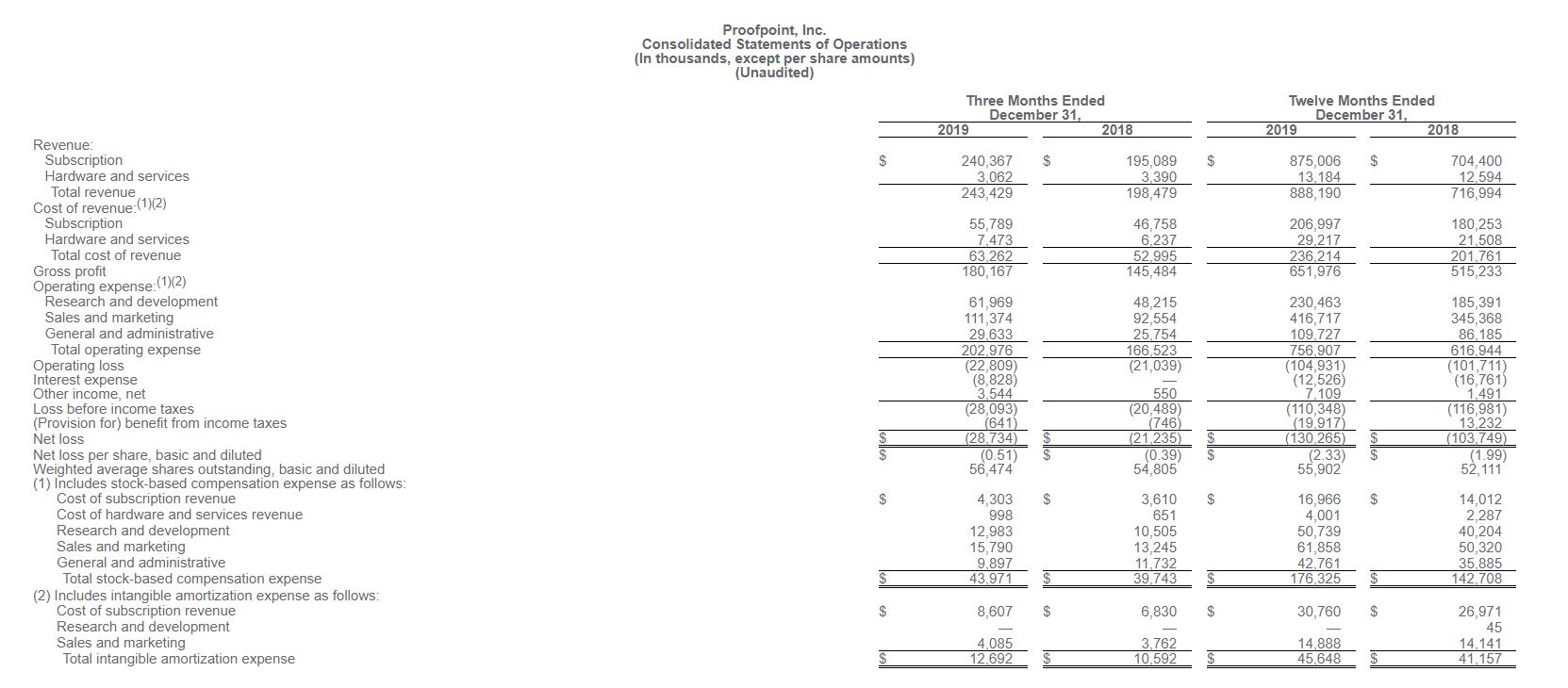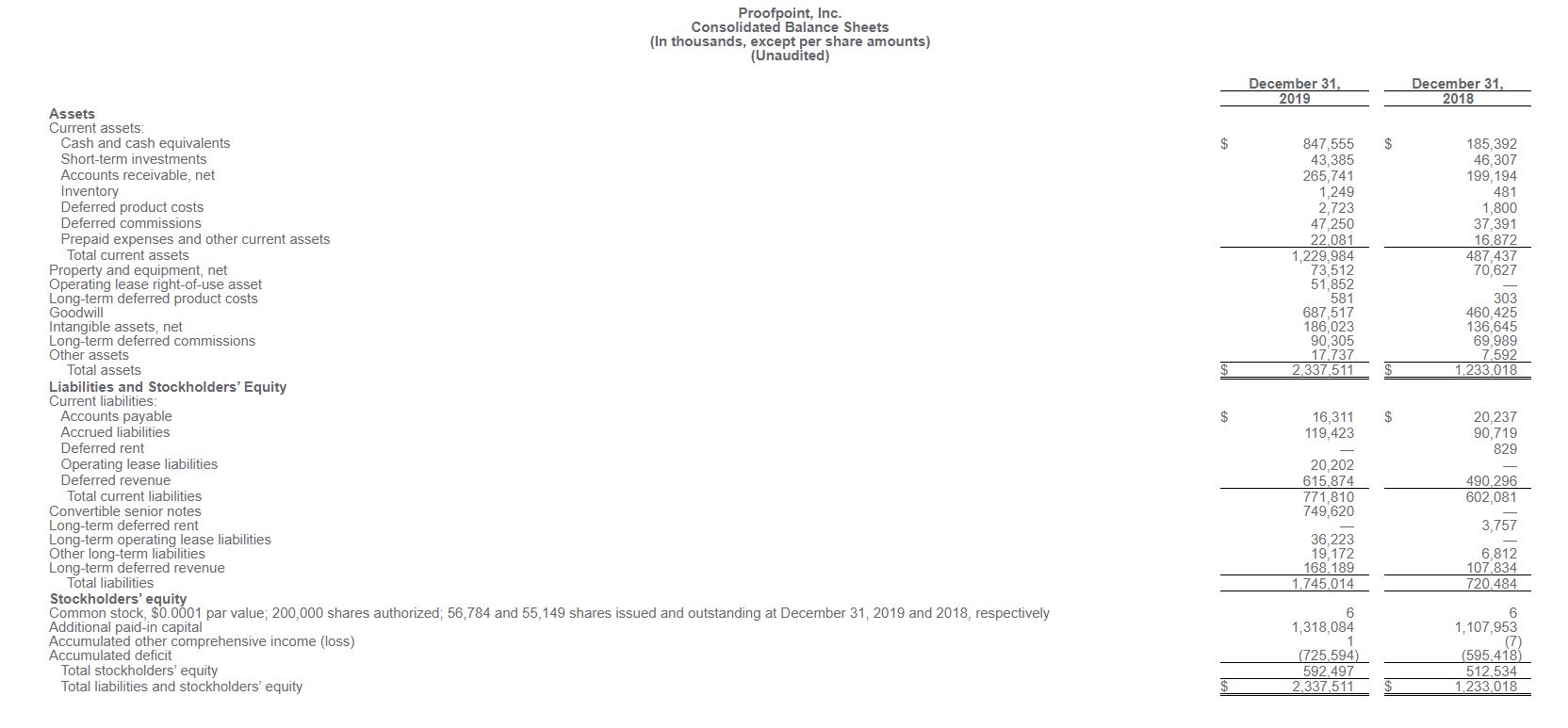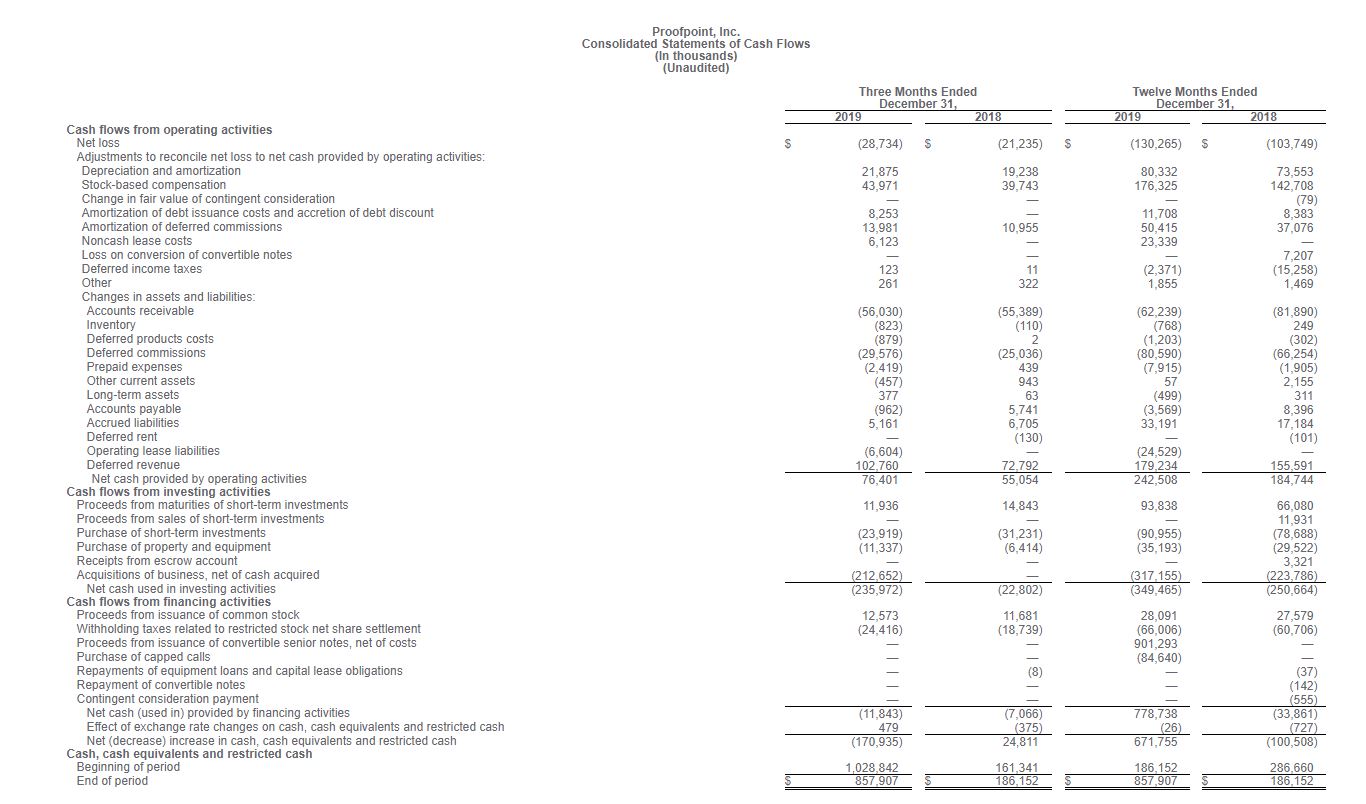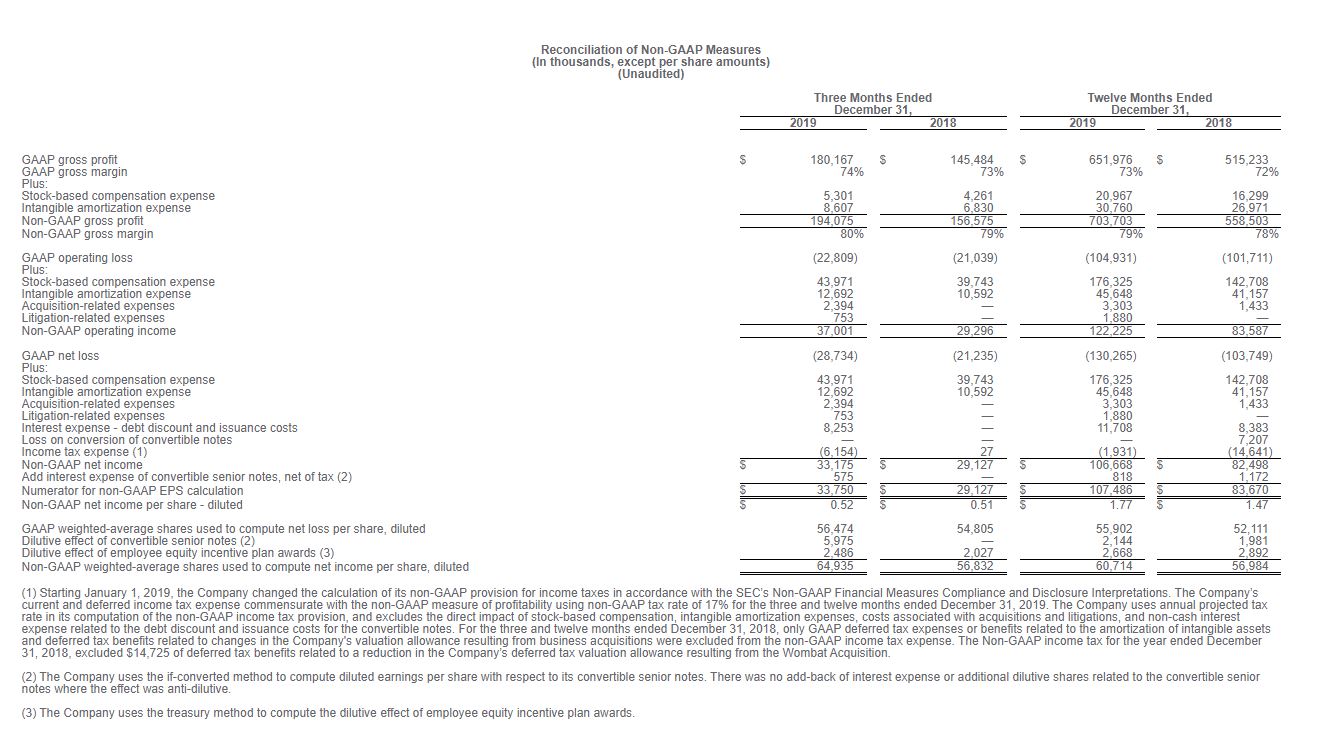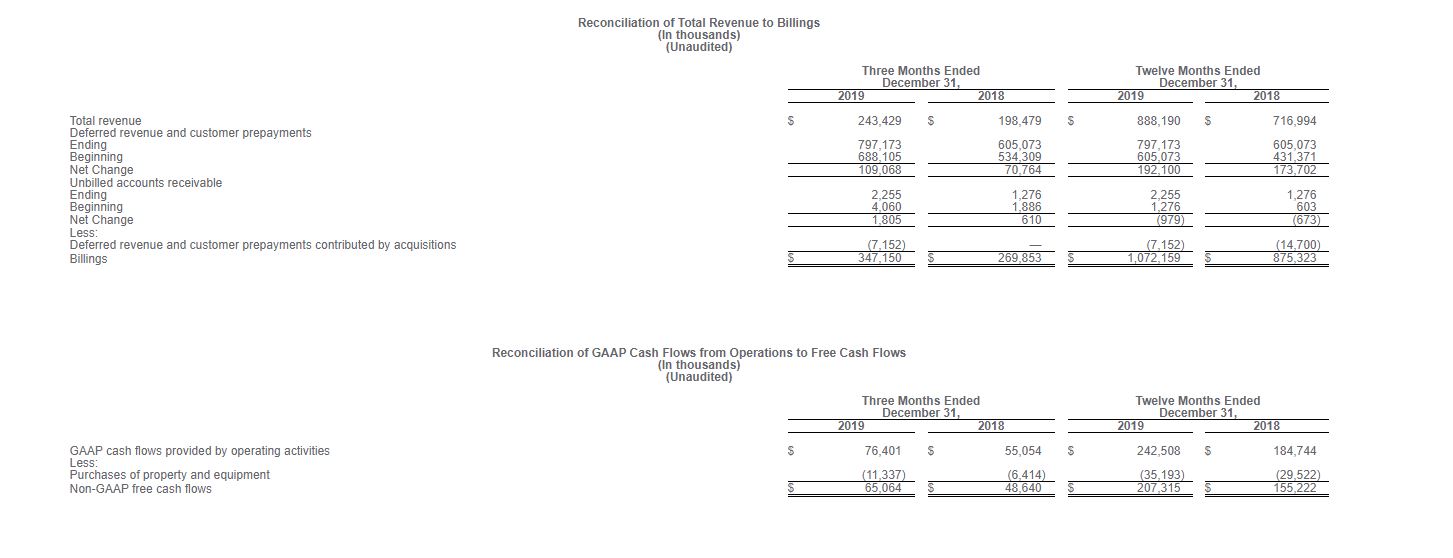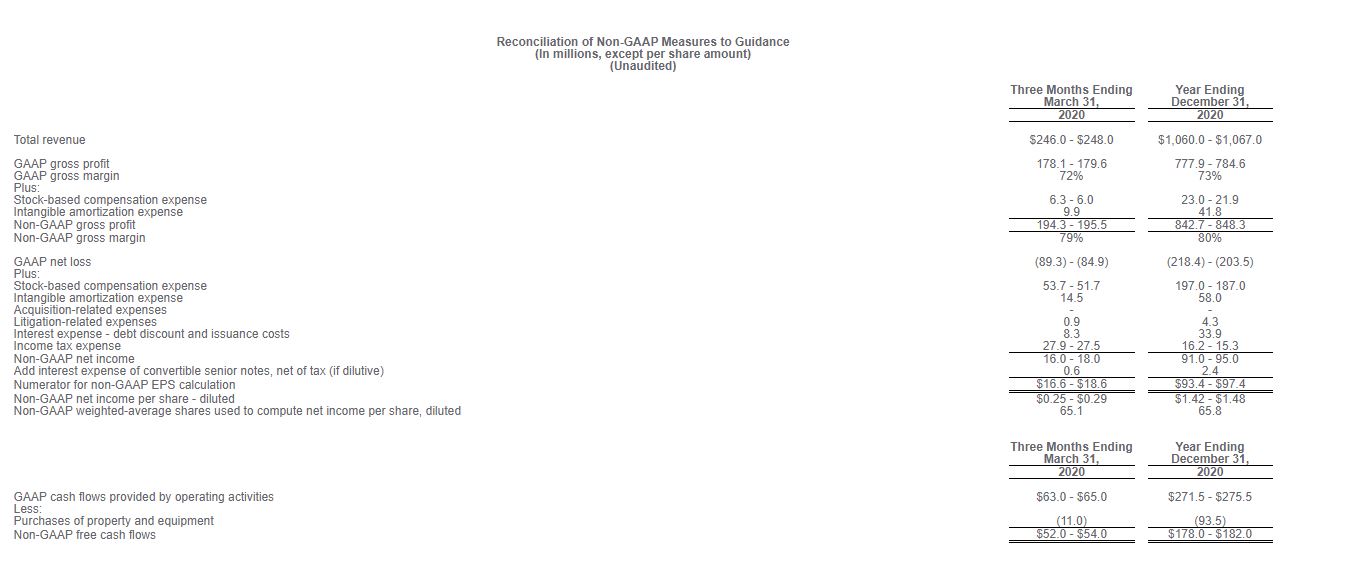Proofpoint Announces Fourth Quarter and Full Year 2019 Financial Results

Fourth Quarter Highlights
- Total revenue of $243.4 million, up 23% year-over-year
- Billings of $347.2 million, up 29% year-over-year
- GAAP EPS of $(0.51) per share, Non-GAAP EPS of $0.52 per share
- Operating cash flow of $76.4 million and free cash flow of $65.1 million
- Increasing FY20 revenue guidance, and all other guided metrics when adjusted for the impact of the acquisition of ObserveIT
SUNNYVALE, Calif., Jan. 30, 2020 -- Proofpoint, Inc. (NASDAQ: PFPT), a leading next-generation security and compliance company, today announced financial results for the fourth quarter and full year ended December 31, 2019.
“We were very pleased with our strong operating results for the fourth quarter and our team’s solid execution throughout the year,” stated Gary Steele, chief executive officer of Proofpoint. “Our people-centric approach to cybersecurity and compliance is gaining traction in the market given today’s threat landscape and the ongoing enterprise migration to the cloud. We firmly believe that the ongoing investments we’re making in scaling our business have us well-positioned to reinforce our competitive position and gain further share globally in the years ahead.”
Fourth Quarter 2019 Financial Highlights
-
Revenue: Total revenue for the fourth quarter of 2019 was $243.4 million, an increase of 23%, compared to $198.5 million for the fourth quarter of 2018.
-
Billings: Total billings for the fourth quarter of 2019 were $347.2 million, an increase of 29%, compared to $269.9 million for the fourth quarter of 2018.
-
Gross Profit: GAAP gross profit for the fourth quarter of 2019 was $180.2 million compared to $145.5 million for the fourth quarter of 2018. Non-GAAP gross profit for the fourth quarter of 2019 was $194.1 million compared to $156.6 million for the fourth quarter of 2018. GAAP gross margin for the fourth quarter of 2019 was 74% compared to 73% for the fourth quarter of 2018. Non-GAAP gross margin for the fourth quarter of 2019 was 80% compared to 79% for the fourth quarter of 2018.
-
Operating Income (Loss): GAAP operating loss for the fourth quarter of 2019 was $(22.8) million compared to a loss of $(21.0) million for the fourth quarter of 2018. Non-GAAP operating income for the fourth quarter of 2019 was $37.0 million compared to $29.3 million for the fourth quarter of 2018.
-
Net Income (Loss): GAAP net loss for the fourth quarter of 2019 was $(28.7) million, or $(0.51) per share, based on 56.5 million weighted average shares outstanding. This compares to a GAAP net loss of $(21.2) million, or $(0.39) per share, based on 54.8 million weighted average shares outstanding for the fourth quarter of 2018. Non-GAAP net income for the fourth quarter of 2019 was $33.2 million, or $0.52 per share, based on 64.9 million weighted average diluted shares outstanding. This result included a $6.8 million income tax expense, calculated using an effective rate of 17%, by applying the SEC’s Non-GAAP Financial Measures Compliance and Disclosure Interpretations (C&DI 102.11) compared to the Company’s historical calculation methodology, and as disclosed on April 25, 2019. Non-GAAP earnings per share for the fourth quarter of 2019 included the shares associated with the company’s convertible notes, and cash interest expense (net of tax) of $0.6 million was added back to net income as the “If-Converted” threshold during this period was achieved.
-
Cash and Cash Flow: As of December 31, 2019, Proofpoint had cash, cash equivalents, and short-term investments of $890.9 million. The company generated $76.4 million in net cash from operations for the fourth quarter of 2019 compared to $55.1 million during the fourth quarter of 2018. The company’s free cash flow for the fourth quarter of 2019 was $65.1 million compared to $48.6 million for the fourth quarter of 2018. Note that this result also included a cash tax payment of $8.4 million for the transfer of certain intellectual property from Israel to the United States associated with the acquisition of Meta Networks.
“We saw exceptional demand for our services in the fourth quarter, driven by further progress with our bundling strategy and emerging products, strong customer retention rates and solid international growth,” stated Paul Auvil, chief financial officer of Proofpoint. “We were particularly pleased with our record billings result in the quarter, and our ability to again exceed our profitability targets further demonstrating our commitment to driving attractive and profitable growth for our shareholders.”
Full Year 2019 Financial Highlights
-
Revenue: Total revenue for the full year of 2019 was $888.2 million, an increase of 24% compared to $717.0 million in 2018.
-
Billings: Total billings for the full year of 2019 were $1,072.2 million, an increase of 22% compared to $875.3 million in 2018.
-
Gross Profit: GAAP gross profit for the full year of 2019 was $652.0 million compared to $515.2 million for 2018. Non-GAAP gross profit for the full year of 2019 was $703.7 million compared to $558.5 million for 2018. GAAP gross margin for the full year of 2019 was 73% compared to 72% for 2018. Non-GAAP gross margin was 79% for the full year of 2019 compared to 78% for 2018.
-
Operating Income (Loss): GAAP operating loss for the full year of 2019 was $(104.9) million compared to a loss of $(101.7) million for 2018. Non-GAAP operating income for the full year of 2019 was $122.2 million compared to $83.6 million for 2018.
-
Net Income (Loss): GAAP net loss for the full year of 2019 was $(130.3) million, or $(2.33) per share, based on 55.9 million weighted average shares outstanding. This compares to a GAAP net loss of $(103.7) million, or $(1.99) per share, based on 52.1 million weighted average shares outstanding for 2018. Note that this result also included a current and deferred GAAP tax expense of $17.6 million for the transfer of certain intellectual property from Israel to the United States in the third quarter of 2019 associated with the acquisition of Meta Networks.
Non-GAAP net income for the full year of 2019 was $106.7 million, or $1.77 per share, based on 60.7 million weighted average diluted shares outstanding. This compares to non-GAAP net income of $82.5 million, or $1.47 per share, based on 57.0 million weighted average diluted shares outstanding for 2018. Net income for the full year 2019 included a $21.8 million income tax expense, calculated using an effective rate of 17%, by applying the SEC’s Non-GAAP Financial Measures Compliance and Disclosure Interpretations (C&DI 102.11) compared to the Company’s historical calculation methodology, and as disclosed on April 25, 2019. Non-GAAP earnings per share for the full years of 2019 and 2018 included the shares associated with the company’s convertible notes, and cash interest expense (net of tax) of $0.8 million and $1.2 million, respectively, were added back to net income as the “If-Converted” threshold during these periods was achieved. -
Cash Flow: The company generated $242.5 million in net cash from operations for the full year of 2019 compared to $184.7 million during 2018. The company generated free cash flow of $207.3 million for the full year of 2019 compared to $155.2 million during 2018.
A reconciliation of GAAP to non-GAAP financial measures has been provided in the financial tables included in this press release. An explanation of these measures and how they are calculated are also included below under the heading “Non-GAAP Financial Measures.”
Financial Outlook
As of January 30, 2020, Proofpoint is providing its first quarter and full year 2020 guidance as follows:
-
First Quarter 2020 Guidance: Total revenue is expected to be in the range of $246.0 million to $248.0 million. GAAP gross margin is expected to be 72%. Non-GAAP gross margin is expected to be approximately 79%. GAAP net loss is expected to be in the range of $(89.3) million to $(84.9) million, or $(1.57) to $(1.49) per share, based on approximately 56.9 million weighted average diluted shares outstanding. This estimate for GAAP net loss includes a GAAP tax expense of approximately $30.0 million for the transfer of certain intellectual property from Israel to the United States that is expected to occur in the first quarter of 2020 associated with the acquisition of ObserveIT. Non-GAAP net income is expected to be in the range of $16.0 million to $18.0 million, or $0.25 to $0.29 per share, using 65.1 million weighted average diluted shares outstanding, and based on our reporting under C&DI 102.11. This includes an estimated $10.0 million of additional expense due to the acquisition of ObserveIT, offset by $1.2 million of revenue to be recognized from the acquired ObserveIT deferred revenue. Free cash flow during the quarter is expected to be in the range of $52.0 million to $54.0 million, which includes a $20.0 million cash tax payment associated with the transfer of certain intellectual property from Israel to the United States, and approximately $10.0 million of cash spending related to the acquisition of ObserveIT. Excluding these payments, free cash flow guidance would have been $82.0 million to $84.0 million. Capital expenditures are expected to be approximately $11.0 million.
-
Full Year 2020 Guidance: Total revenue is expected to be in the range of $1,060.0 million to $1,067.0 million. GAAP gross margin is expected to be 73%. Non-GAAP gross margin is expected to be 80%. GAAP net loss is expected to be in the range of $(218.4) million to $(203.5) million, or $(3.80) to $(3.54) per share, based on approximately 57.5 million weighted average diluted shares outstanding. This estimate for GAAP net loss includes a GAAP tax expense of approximately $30.0 million for the transfer of certain intellectual property from Israel to the United States that is expected to occur in the first quarter of 2020 associated with the acquisition of ObserveIT. Non-GAAP net income is expected to be in the range of $91.0 million to $95.0 million, or $1.42 to $1.48 per share, using 65.8 million weighted average diluted shares outstanding, and based on our reporting under C&DI 102.11. This includes an estimated $40.0 million of additional expense due to the acquisition of ObserveIT, offset by $3.7 million of revenue to be recognized from the acquired ObserveIT deferred revenue. Free cash flow is expected to be in the range of $178.0 million to $182.0 million. This includes an estimated $25.0 million in net cash to be used in the build-out of the Company’s new corporate headquarters which was already contemplated in the Company’s prior guidance. In addition, this guidance now assumes an estimated $20.0 million cash tax payment associated with the transfer of certain intellectual property from Israel to the United States, and approximately $40.0 million of cash spending related to the acquisition of ObserveIT, offset by approximately $5.0 million of expected ObserveIT customer contract renewals. Excluding these payments, free cash flow guidance would have been $258.0 million to $262.0 million. Capital expenditures are expected to be approximately $93.5 million.
Quarterly Conference Call
Proofpoint will host a conference call today at 1:30 p.m. Pacific Time (4:30 p.m. Eastern Time) to review the company’s financial results for the fourth quarter ended December 31, 2019. To access this call, dial (800) 458-4121 for the U.S. or Canada, or (929) 477-0324 for international callers, with conference ID #7566656. A live webcast, and an archived recording of the conference call will be accessible from the Investors section of Proofpoint’s website at investors.proofpoint.com. An audio replay of this conference call will also be available through February 13, 2020, by dialing (844) 512-2921 for the U.S. or Canada or (412) 317-6671 for international callers, and entering passcode #7566656.
About Proofpoint, Inc.
Proofpoint, Inc. (NASDAQ: PFPT) is a leading cybersecurity company that protects organizations’ greatest assets and biggest risks: their people. With an integrated suite of cloud-based solutions, Proofpoint helps companies around the world stop targeted threats, safeguard their data, and make their users more resilient against cyber attacks. Leading organizations of all sizes, including more than half of the Fortune 1000, rely on Proofpoint for people-centric security and compliance solutions that mitigate their most critical risks across email, the cloud, social media, and the web. More information is available at www.proofpoint.com.
Proofpoint is a trademark or registered trademark of Proofpoint, Inc. in the U.S. and other countries. All other trademarks contained herein are the property of their respective owners.
Forward-Looking Statements
This press release contains forward-looking statements that involve risks and uncertainties. These forward-looking statements include statements regarding momentum in the company’s business, market position, win rates and renewal rates, future growth, and future financial results. It is possible that future circumstances might differ from the assumptions on which such statements are based. Important factors that could cause results to differ materially from the statements herein include: failure to maintain or increase renewals and increased business from existing customers and failure to generate increased business through existing or new channel partner relationships; uncertainties related to continued success in sales growth and market share gains; failure to convert sales opportunities into definitive customer agreements; risks associated with successful implementation of multiple integrated software products and other product functionality; competition, particularly from larger companies with more resources than Proofpoint; risks related to new target markets, new product introductions and innovation and market acceptance thereof; the ability to attract and retain key personnel; potential changes in strategy; risks associated with management of growth; lengthy sales and implementation cycles, particularly in larger organizations; the time it takes new sales personnel to become fully productive; unforeseen delays in developing new technologies and the uncertain market acceptance of new products or features; technological changes that make Proofpoint’s products and services less competitive; security breaches, which could affect our brand; the costs of litigation; the impact of changes in foreign currency exchange rates; the effect of general economic conditions, including as a result of specific economic risks in different geographies and among different industries; risks related to integrating the employees, customers and technologies of acquired businesses; assumption of unknown liabilities from acquisitions; ability to retain customers of acquired entities; and the other risk factors set forth from time to time in our filings with the SEC, including our Quarterly Report on Form 10-Q for the three months ended September 30, 2019, and the other reports we file with the SEC, copies of which are available free of charge at the SEC’s website at www.sec.gov or upon request from our investor relations department. All forward-looking statements herein reflect our opinions only as of the date of this release, and Proofpoint undertakes no obligation, and expressly disclaims any obligation, to update forward-looking statements herein in light of new information or future events.
Computational Guidance on Earnings Per Share Estimates
Accounting principles require that EPS be computed based on the weighted average shares outstanding (“basic”), and also assuming the issuance of potentially issuable shares (such as those subject to stock options, convertible notes, etc.) if those potentially issuable shares would reduce EPS (“diluted”).
The number of shares related to options and similar instruments included in diluted EPS is based on the “Treasury Stock Method” prescribed in Financial Accounting Standards Board (“FASB”) ASC Topic 260, Earnings Per Share (“FASB ASC Topic 260”). This method assumes a theoretical repurchase of shares using the proceeds of the respective stock option exercise at a price equal to the issuer’s average stock price during the related earnings period. Accordingly, the number of shares includable in the calculation of diluted EPS in respect of stock options and similar instruments is dependent on this average stock price and will increase as the average stock price increases.
The number of shares includable in the calculation of diluted EPS in respect of convertible senior notes is based on the “If Converted” method prescribed in FASB ASC Topic 260. This method assumes the conversion or exchange of these securities for shares of common stock. In determining if convertible securities are dilutive, the interest savings (net of tax) subsequent to an assumed conversion are added back to net earnings. The shares related to a convertible security are included in diluted EPS only if EPS as otherwise calculated is greater than the interest savings, net of tax, divided by the shares issuable upon exercise or conversion of the instrument. Accordingly, the calculation of diluted EPS for these instruments is dependent on the level of net earnings.
Non-GAAP Financial Measures
We have provided in this release financial information that has not been prepared in accordance with GAAP. We use these non-GAAP financial measures internally in analyzing our financial results and believe they are useful to investors, as a supplement to GAAP measures, in evaluating our ongoing operational performance. We believe that the use of these non-GAAP financial measures provides an additional tool for investors to use in evaluating ongoing operating results and trends and in comparing our financial results with other companies in our industry, many of which present similar non-GAAP financial measures to investors.
Non-GAAP financial measures should not be considered in isolation from, or as a substitute for, financial information prepared in accordance with GAAP. Investors are encouraged to review the reconciliation of these non-GAAP financial measures to their most directly comparable GAAP financial measures below. As previously mentioned, a reconciliation of our non-GAAP financial measures to their most directly comparable GAAP measures has been provided in the financial statement tables included below in this press release.
Non-GAAP gross profit and gross margin. We define non-GAAP gross profit as GAAP gross profit, adjusted to exclude stock-based compensation expense and the amortization of intangibles associated with acquisitions. We define non-GAAP gross margin as non-GAAP gross profit divided by GAAP revenue. We consider these non-GAAP financial measures to be useful metrics for management and investors because they exclude the effect of non-cash charges that can fluctuate for Proofpoint, based on timing of equity award grants and the size, timing and purchase price allocation of acquisitions so that our management and investors can compare our recurring core business operating results over multiple periods. There are a number of limitations related to the use of non-GAAP gross profit and non-GAAP gross margin versus gross profit and gross margin, in each case, calculated in accordance with GAAP. For example, stock-based compensation has been and will continue to be for the foreseeable future a significant recurring expense in our business. Stock-based compensation is an important part of our employees’ compensation and impacts their performance. In addition, the components of the costs that we exclude in our calculation of non-GAAP gross profit and non-GAAP gross margin may differ from the components that our peer companies exclude when they report their non-GAAP results. Management compensates for these limitations by providing specific information regarding the GAAP amounts excluded from non-GAAP gross profit and non-GAAP gross margin and evaluating non-GAAP gross profit and non-GAAP gross margin together with gross profit and gross margin calculated in accordance with GAAP.
Non-GAAP operating income. We define non-GAAP operating income as operating loss, adjusted to exclude stock-based compensation expense and the amortization of intangibles and costs associated with acquisitions and litigation. Costs associated with acquisitions include legal, accounting, and other professional fees, as well as changes in the fair value of contingent consideration obligations. We consider this non-GAAP financial measure to be a useful metric for management and investors because it excludes the effect of stock-based compensation expense and the amortization of intangibles and costs associated with acquisitions and litigation so that our management and investors can compare our recurring core business operating results over multiple periods. There are a number of limitations related to the use of non-GAAP operating income versus operating loss calculated in accordance with GAAP. For example, as noted above, non-GAAP operating income excludes stock-based compensation expense. In addition, the components of the costs that we exclude in our calculation of non-GAAP operating income may differ from the components that our peer companies exclude when they report their non-GAAP results of operations, and some of these items are cash-based. Management compensates for these limitations by providing specific information regarding the GAAP amounts excluded from non-GAAP operating income and evaluating non-GAAP operating income together with operating loss calculated in accordance with GAAP.
Non-GAAP net income. We define non-GAAP net income as net loss, adjusted to exclude stock-based compensation expense, amortization of intangibles, costs associated with acquisitions and litigation, non-cash interest expense related to the convertible debt discount and issuance costs for the convertible debt offering, loss on conversion of convertible debt, and tax effects. We consider this non-GAAP financial measure to be a useful metric for management and investors for the same reasons that we use non-GAAP operating income.
Starting January 1, 2019, we changed the calculation of our non-GAAP provision for income taxes in accordance with the SEC’s Non-GAAP Financial Measures Compliance and Disclosure Interpretations. Our current and deferred income tax expense is commensurate with the non-GAAP measure of profitability using a non-GAAP tax rate of 17% for the three months and the year ended December 31, 2019. We use an annual projected tax rate in a computation of the non-GAAP income tax provision, and exclude the impact of stock-based compensation, intangible amortization expenses, costs associated with acquisitions and litigations, and non-cash interest expense related to the debt discount and issuance costs for the convertible notes. The projected rate considers other factors such as our current operating structure, existing tax positions in various jurisdictions, and key legislation in major jurisdictions where we operate.
Billings. We define billings as revenue recognized plus the change in deferred revenue and customer prepayments less change in unbilled accounts receivable from the beginning to the end of the period, but excluding additions to deferred revenue and customer prepayments from acquisitions. Customer prepayments represent billed amounts for which the contract can be terminated and the customer has a right of refund. Unbilled accounts receivable represent amounts for which the company has recognized revenue, pursuant to its revenue recognition policy, for subscription software already delivered and professional services already performed, but billed in arrears and for which the company believes it has an unconditional right to payment. We consider billings to be a useful metric for management and investors because billings drive deferred revenue, which is an important indicator of the health and visibility of our business, and has historically represented a majority of the quarterly revenue that we recognize. There are a number of limitations related to the use of billings versus revenue calculated in accordance with GAAP. Billings include amounts that have not yet been recognized as revenue, but exclude additions to deferred revenue from acquisitions. We may also calculate billings in a manner that is different from other companies that report similar financial measures. Management compensates for these limitations by providing specific information regarding GAAP revenue and evaluating billings together with revenues calculated in accordance with GAAP.
Free cash flow. We define free cash flow as net cash provided by operating activities minus capital expenditures. We consider free cash flow to be a liquidity measure that provides useful information to management and investors about the amount of cash generated by the business that, after the acquisition of property and equipment, can be used for strategic opportunities, including investing in our business, making strategic acquisitions, and strengthening the balance sheet. Analysis of free cash flow facilitates management’s comparisons of our operating results to competitors’ operating results. A limitation of using free cash flow versus the GAAP measure of net cash provided by operating activities as a means for evaluating our company is that free cash flow does not represent the total increase or decrease in the cash balance from operations for the period because it excludes cash used for capital expenditures during the period. Management compensates for this limitation by providing information about our capital expenditures on the face of the cash flow statement and in the “Management’s Discussion and Analysis of Financial Condition and Results of Operations - Liquidity and Capital Resources” section of our quarterly and annual reports filed with the SEC.
